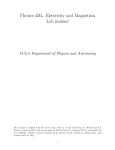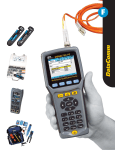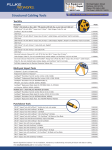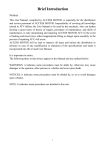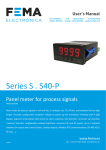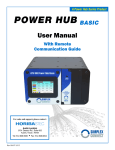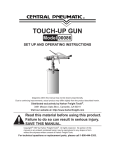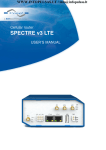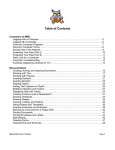Download to Down Load GEM 1 User Manual
Transcript
945 North Trimble Road P.O. Box 1443 Mansfield, Ohio 44901 GEM 1/GEM 1E Genius Environmental Monitor Series 1 Reference Manual Copyright© Signals Power & Grounding Specialists, Inc., 1999 All Rights Reserved. 0199 Signals Power and Grounding Specialists, Inc. 945 North Trimble Road, Mansfield OH GEMS1 Reference Manual Table of Contents 1 INTRODUCTION.................................................................................................................................................................1 2 INSTALLATION .................................................................................................................................................................2 2.1 General Information ...................................................................................................................................................2 2.2 Electrical Requirement...............................................................................................................................................2 2.3 Tool Requirements ....................................................................................................................................................2 2.4 Material Requirements ..............................................................................................................................................2 2.5 Mounting....................................................................................................................................................................2 2.6 Power Connection .....................................................................................................................................................2 2.7 Ground Connections..................................................................................................................................................3 2.8 Fuse Alarm Connections...........................................................................................................................................3 2.9 GEMS1 Calibration....................................................................................................................................................3 2.10 Parameter Settings ....................................................................................................................................................3 2.11 Alarm Reporting.........................................................................................................................................................4 2.12 Alarm Latching Selection...........................................................................................................................................4 2.13 AC RMS/Peak Selection ..........................................................................................................................................4 2.14 Alarm Enabling & Disabling.......................................................................................................................................4 2.15 Sensor Installation......................................................................................................................................................5 2.16 GEM 1E Option.........................................................................................................................................................5 3 ADMINISTRATION ............................................................................................................................................................6 3.1 Alarm Parameter Adjustment....................................................................................................................................6 3.2 Extension Cable/Sensor Testing...............................................................................................................................6 4 SPECIFICATIONS .............................................................................................................................................................8 4.1 Physical Characteristics............................................................................................................................................8 4.2 Electrical Characteristics ...........................................................................................................................................8 INSTALLATION KIT ......................................................................................................................................................................12 INSTALLATION TOOLS...............................................................................................................................................................12 List of Illustrations Figure 1, Front Panel............................................................................................................................................................................9 Figure 2, Rear Panel..........................................................................................................................................................................10 Figure 3, Alarm Contact Output Connector Configuration...................................................................................................................11 Figure 4, Alarm Select DIP Switch Configuration...............................................................................................................................11 Copyright© SPGS, Inc. 1999 All Rights Reserved. i Signals Power and Grounding Specialists, Inc. 945 North Trimble Road, Mansfield OH 1 1.1 GEMS1 Reference Manual INTRODUCTION 1.3 The Genius Environment Monitor Series 1 is part of the electrical environment monitoring family manufactured by Signals Power and Grounding Specialists, Inc. The GEMS1 units, which include the GEM 1E, are capable of continuously monitoring both AC and DC current on a single conductor. The units may be ordered with a standard 20 Amp configuration, or an optional 200 Amp configuration. The GEMS1 units provide a real-time display of current on the monitored conductor. The unit is capable of comparing current present with userselected threshold settings. Thresholds may be set at both AC and DC, High and Low comparison points. When the monitored current exceeds a predetermined threshold point, the actual reading illuminates the LED, indicating an alarm condition. Optional alarm cables will allow a customer's external alarm or data collection system to also indicate the condition. The GEMS1 standard mounting configuration accommodates 19" equipment frames. Extension plates are available separately for 23" equipment frame mounting. 1.2 Purpose of this manual is to provide beneficial information for: • Planning • Engineering • Installing GEMS1 units • Administration of GEMS1 units Copyright© SPGS, Inc. 1999 All Rights Reserved. 1 1.4 Project Planning for GEMS1 equipment: • Project planning and coordination • Define site requirements • Select conductors to monitor • Install a GEMS1 • Configure a GEMS1 • Maintain a GEMS1 Intended Audience: • Project engineers • Equipment engineers • Land and Building engineers • Installers • Maintenance technicians • Administration personnel • Management Signals Power and Grounding Specialists, Inc. 945 North Trimble Road, Mansfield OH 2 2.1 GEMS1 Reference Manual INSTALLATION 2.4 General Information Material Requirements • Unpacking • • Handle parts with care. Verify items below are included: 1 - GEMS1 Unit 1 - Current Sensor 1 - Extension Cable 4 - Screws, Philip (frame mounting) 1 - RJ45 Calibration Plug 2 - Frame Mount Brackets 4 - Screws, Flat (bracket mounting) 1 - Trimmer Adjustment Tool 1 - Operations Manual 1 - Spare 1/2 Amp GMT Fuse Note: 2.5 2.3 Sensors available in 20 or 200 Amp 2.6 The unit requires a DC power source that will provide voltage within a range of 20-70 volts. Correct polarity must be observed. (The GEMS1 units [front panel] are equipped with a 1/2 Amp fuse for internal circuit protection.) Tool Requirements • • • Flat Blade Screwdriver Phillips Blade Screwdriver AC/DC Hand-held Amp Probe Copyright© SPGS, Inc. 1999 All Rights Reserved. Attach the two (2) Equipment Frame Mounting Brackets (Fig. 1, Item 20), supplied with the unit, to the GEMS1 unit using the four (4) mounting screws provided. Note: Electrical Requirement • Mounting • Optional items: 1 - Alarm Cable (GEM 1) 1 - Set Extension Plates (23"mount) 1 - Data Interface Cable (GEM 1E) 2.2 Insulated Copper Wire per customer specifications for: - Power (+) & (-) - Shield Ground - Chassis Ground 2 The unit depth is adjustable by selecting desired depth and mounting brackets at that depth. • Secure the GEMS1 in the selected equipment frame with the four (4) mounting screws provided. • Optional 23" extension plate kits must be ordered separately. Power Connection • • Connect the (+) lead to terminal block TB-1 (Fig. 2, Item 23), located on the rear panel. Connect the (-) lead to terminal block TB-2 (Fig. 2, Item 24), located on the rear panel. Signals Power and Grounding Specialists, Inc. 945 North Trimble Road, Mansfield OH 2.7 Ground Connections • • • Insert the RJ45 calibration plug into the Sensor Input Connector (Fig. 2, Item 31), located on the rear panel. Connect an insulated grounding conductor for Chassis Ground to terminal block TB-4 (Fig. 2, Item 26), located on the rear panel. • Set the AC/DC Select Switch to AC (Fig. 1, Item 4), located on the front panel. • While observing the Panel Meter Display (Fig. 1, Item 2), located on the front panel, calibrate the AC Offset. Adjust the AC OFF adjustment pot (Fig. 1, Item 12), located on the front panel, until the Panel Display Meter reads 00.00 ±.01. • Set the AC/DC Select Switch to DC (Fig. 1, Item 4), located on the front panel. • While observing the Panel Meter Display (Fig. 1, Item 2), located on the front panel, calibrate the DC Offset. Adjust the DC OFF adjustment pot (Fig. 1, Item 15), located on the front panel, until Panel M eter Display reads 00.00 ±.01. • Remove the RJ45 calibration plug. • Disregard any changes in the reading on the Panel Meter Display at this time. • The GEMS1 unit is now calibrated. Separate grounding conductors MUST be used for Chassis Ground and Shield Ground. Fuse Alarm Connections • • Connect the Fuse Alarm Input leads, Common (COM) and Normally Open (N/O) to TB5 and 6 (Fig. 2, Items 27 and 28), located on the rear panel. Connect the Fuse Alarm Output leads, Common (COM) and Normally Open (N/O) to TB7 and 8 (Fig. 2, Items 29 and 30), located on the rear panel. Note: 2.9 With the sensor removed from the GEMS1, calibration can be performed. Connect an insulated grounding conductor for Shield Ground to terminal block TB-3 (Fig. 2, Item 25), located on the rear panel. Note: 2.8 GEMS1 Reference Manual The input and output fuse alarm leads are internally connected for chaining of the alarm leads. GEMS1 Calibration Unit must have power on prior to calibration. 2.10 • Set the Power ON/OFF Switch to the ON position (Fig. 2, Item 21), located on the rear panel. • The Power LED Indicator will illuminate (Fig. 1, Item 3), located on the front panel. Copyright© SPGS, Inc. 1999 All Rights Reserved. 3 Parameter Settings Each alarm parameter is adjustable, although thresholds are preset for monitoring of safety conductors. They are shipped as follows: Signals Power and Grounding Specialists, Inc. 945 North Trimble Road, Mansfield OH GEMS1 Reference Manual DC High -.25 amps DC Low +.25 amps AC High +.25 amps AC Low DISABLED Note: 2.11 See Section 3.1., Alarm Parameter Adjustment, for detailed information prior to making adjustments. • • An alarm condition will exist when the sensor's current reading exceeds the high parameter setting, or falls below the low parameter setting on either the AC or DC current readings. This condition must exist for more than 250ms. • When an alarm condition exists, it will be reported via its respective Alarm Indicator LED (Fig. 1, Items 16-19), located on the front panel, and the Alarm Contact Output Connector (Fig. 2, Item 33), located on the rear panel. (For pin-out configuration see Fig. 3) 2.13 Alarm Latching Selection • 2.14 When the Alarm Latch Switch (Fig. 1, Item 7), located on front panel, is set to the OFF position, the following applies: Copyright© SPGS, Inc. 1999 All Rights Reserved. 4 AC RMS/Peak Selection Factory shipped with RMS selected The Alarm Contact Output Connector (Fig. 2, Item 33) provides the user with a closed or open circuit (user selectable) for interfacing with an alarm reporting device. The GEMS1 alarm outputs are designed to work with cross platforms in mind (e.g., Ground and/or Battery signals). Factory shipped in the OFF position When the Alarm Latch Switch (Fig. 1, Item 7), located on front panel, is set to the ON position, the following applies: Once an alarm condition exists, the GEMS1 will latch the alarm in the active state. The alarm will remain active even if the alarm condition is cleared. The respective alarm LED and contact output will stay latched until both the alarm condition is cleared and the Alarm Latch Reset Button (Fig. 1, Item 8), located on the front panel, is depressed and released. Alarm Reporting • 2.12 Once an alarm condition exists, the respective LED, and contact output will remain activated only for the duration of the alarm condition. • When the AC RMS/Peak Select Switch (Fig. 1, Item 9), located on front panel, is set to the RMS position, the AC component of the sensor input signal will be represented by its TrueRMS value. • When the AC RMS/Peak Select Switch (Fig. 1, Item 9), located on front panel, is set to the Peak position, the AC component of the sensor input signal will be represented by its actual peak value. Alarm Enabling & Disabling Factory shipped with the AC Low alarm disabled and all other alarms enabled. Signals Power and Grounding Specialists, Inc. 945 North Trimble Road, Mansfield OH • • • 2.15 GEMS1 Reference Manual The GEMS1 is equipped with an Alarm Select Dip Switch (Fig. 2, Item 32), located on the rear panel. The Alarm Select Dip Switch consists of four separate switches, each of which will enable/disable any of the four (4) alarm reporting output types (DC H/L, AC H/L). (For switch setting configuration see Fig. 4) While an alarm output is disabled, its respective Alarm Indicator LED (Fig. 1, Items 1619), located on the front panel, and respective Alarm Contact Output Connector contact set (Fig. 2, Item 33), located on the rear panel, will be deactivated. Sensor Installation • GEM 1E Option The GEM 1E provides an interface to simulate a 50 MV shunt output for an existing Data Collection device. All previous installation instructions also apply. 2.16.1 Interface to Existing Data Collection Unit The supplied interface cables (2 twisted pair) are attached in the following manner: • Connect the DC+ lead to terminal block TB-9 (Fig.2, Item 34). located on the rear panel. • Connect the Common DC- lead to terminal block TB-10 (Fig.2, Item 35) located on the rear panel. • Connect the Common AC+ lead to terminal block TB-12 (Fig.2, Item 37) located on the rear panel. • Connect the AC- lead to terminal block TB-11 (Fig.2, Item 36) located on the rear panel. Place the sensor assembly in the approximate location of the conductor to be monitored. Note: Do not place a sensor around the conductor at this time. • Allow approximately five (5) minutes for the sensor to stabilize and adjust to room temperature. • Route the extension cable from the GEMS1 unit and attach to the sensor. • Insert the extension cable into the Sensor Input Connector (Fig. 2, Item 31), located on the rear panel of the GEMS1 unit. • Carefully place the sensor around the conductor to be monitored. Make sure the stenciling on the sensor is facing the ground bar, the sensor is fastened securely, and the conductor is in the center of the sensor core. The Panel Meter Display (Fig. 1, Item 2) reading now indicates actual current flow, if any, on the conductor monitored. • 2.16 Copyright© SPGS, Inc. 1999 All Rights Reserved. 5 Signals Power and Grounding Specialists, Inc. 945 North Trimble Road, Mansfield OH 3 GEMS1 Reference Manual ADMINISTRATION settings. 3.1 Alarm Parameter Adjustment Note: 3.1.1 Factory settings can be modified. Increasing parameter adjustments for safety conductors is not recommended except for a temporary period of time. For example, locating and correcting the source of an alarm condition. To adjust, see 3.1.3 for details. 3.1.2 If the monitored conductor is NOT a safety conductor, adjustments should be made. See 3.1.3 for details. 3.1.3 If a different predetermined alarm parameter is desired, use a hand-held AC/DC Amp Probe to obtain readings from the conductor to be monitored. These readings will be necessary to establish the parameter settings, which are adjusted as follows: 3.2 Extension Cable/Sensor Testing It is recommended that all non-factory supplied extension cables and previously used cables or sensors be re-tested prior to installation. SPGS can provide this service. If customer would like to test these items, equipment required for testing includes: • • • • • • • • Set the AC/DC Select Switch (Fig. 1, Item 4), located on the front panel, to either AC or DC. This is determined by the desired parameter that will be adjusted. 3.2.1 Set the Alarm Hi/Lo Select Switch (Fig. 1, Item 6), located on the front panel, to either High or Low. This is determined by the desired parameter that will be adjusted. Press and hold the Alarm Set Button (Fig. 1, Item 5), located on the front panel, while observing the Panel Meter Display (Fig. 1, Item 2), located on the front panel. The display indicates the present alarm parameter setting. To change the displayed parameter setting, continue to hold the Alarm Set Button, and adjust the respective Parameter Adjustment Pot (Fig. 1, Items 10, 11, 13, and 14), located on the front panel, until the Panel Meter Display shows the desired setting. Follow the above steps for the AC and DC, HIGH and LOW alarm parameter adjustment Copyright© SPGS, Inc. 1999 All Rights Reserved. 6 On the DC reading of negative numbers, the more negative of the two numbers is said to be lower. (i.e. 100.0 amps is lower than 50.0 amps.) 3.2.2 Remote Cable Tester capable of testing open/short RJ-45 cable connectors 70 Ohm Cable Tester (manufactured by SPGS) Volt Ohm Meter Extension Cable - Test #1 • Insert one end of the extension cable into master's RJ-45 jack of the Remote Cable Tester. • Insert the other end of the extension cable into remote RJ-45 jack of the Remote Cable Tester. • Follow manufacturer's operation instructions for the cable tester. • The extension cable must pass this test before installation of the GEMS1 can continue. • If the extension cable does not pass the test, change both module plugs and retest or return to Signals Power and Grounding Specialists for repair. Sensor Test • Set the volt ohm meter to measure ohms. Signals Power and Grounding Specialists, Inc. 945 North Trimble Road, Mansfield OH GEMS1 Reference Manual • Insert the 70 Ohm Cable Tester: red lead to the VOLT OHM of the meter and black lead of the tester to the COM of the meter. • Insert the sensor into the 70 ohm cable tester. (The reading on the volt ohm meter should be between 67 ohms and 73 ohms.) • The sensor must pass the above test before continuing with installation of the GEMS1. • If the sensor does not pass the test, return the sensor to Signals Power and Grounding Specialists for repair. Copyright© SPGS, Inc. 1999 All Rights Reserved. 7 Signals Power and Grounding Specialists, Inc. 945 North Trimble Road, Mansfield OH 4 4.1 4.2 GEMS1 Reference Manual SPECIFICATIONS Accurate to within ±1% Physical Characteristics • Unit Size (HxWxD) Weight • Maximum conductor size 2" Diameter • Sensor size (HxWxD) Weight 7" x 5" x 1" 0.9 lb. • Resolution: 20 amp 0.01 200 amp 0.10 • Frequency range AC: 5 Hz to 1 KHz DC: 0 to 1 Hz • Minimum pulse detection 250 ms • GEM 1 output L.E.D. Display Dry contact source Internal LCD meter • GEM 1E output L.E.D. Display Dry contact source Internal LCD meter AC 50 MV shunt DC 50 MV shunt 3.5" x 9" x 17" 4.6 lbs. Electrical Characteristics • Supply Voltage Requirement DC: 20VDC to 70VDC • Supply Current Level DC: 250 mA max. • Power Consumption DC: 5 W max. • Input Fuse Alarm contact rating 1 Amps at 60V • Parameter Alarm contact rating 1 Amps at 60V • Monitoring range: 20 Amp Sensor AC: 0.01 to 19.99 Amps DC: -19.99 to 19.99 Amps 4.3 200 Amp Sensor AC: 0.1 to 199.9 Amps DC: -199.9 to 199.9 Amps • • Alarm settings: 20 Amp Sensor AC: 0 to 19.99 Amps DC: -19.99 to 19.99 Amps 200 Amp Sensor AC: 0 to 19.99 Amps DC: -199.9 to 199.9 Amps AC/DC readings: Copyright© SPGS, Inc. 1999 All Rights Reserved. 8 Environmental Characteristics • Operating Temperature Normal 59 F - 89 F (15 C - 30 C) Maximum 32 F - 120 F (0 C - 40 C) • Relative Humidity 30-80% non-condensing Signals Power and Grounding Specialists, Inc. North Trimble Road, Mansfield OH GEMS1 Reference Manual GEMS 1 MONITORING SYSTEM Figure 1, Front Panel 1 2 3 4 5 6 7 Input Fuse 0.5A Panel Meter Display Power LED Indicator AC/DC Select Switch Alarm Set Button Alarm Hi/Lo Select Switch Alarm Latch Switch 8 9 10 11 12 13 14 Alarm Latch Reset Button AC Peak/RMS Select Switch AC High Parameter Adjustment Pot AC Low Parameter Adjustment Pot AC Offset Adjustment Pot DC High Parameter Adjustment Pot DC Low Parameter Adjustment Pot Copyright© SPGS, Inc. 1998 All Rights Reserved. 9 15 16 17 18 19 20 DC Offset Adjustment Pot AC High Alarm Indicator LED AC Low Alarm Indicator LED DC High Alarm Indicator LED DC Low Alarm Indicator LED 19" Rack Mount Brackets Signals Power and Grounding Specialists, Inc. North Trimble Road, Mansfield OH GEMS1 Reference Manual Figure 2, Rear Panel 21 22 23 24 25 26 Power ON/OFF Switch Terminal Block (+) Return Connection (TB-1) (-) Power Connection (TB-2) Shield Ground Connection (TB-3) Chassis Ground Connection (TB-4) 27 28 29 30 31 32 Fuse Alarm Input, Com. Conn (TB-5) Fuse Alarm Input, N.O. Conn (TB-6) Fuse Alarm Output, Com. Conn (TB-7) Fuse Alarm Output, N.O. (TB-8) Sensor Input Connector Alarm Select DIP Switch Copyright© SPGS, Inc. 1998 All Rights Reserved. . 10 33 34 35 36 37 Alarm Contact Output Connector DC + (TB-9) (GEM 1E Only) DC - (TB-10) (GEM 1E Only) AC - (TB-11) (GEM 1E Only) AC + (TB-12) (GEM 1E Only) Signals Power and Grounding Specialists, Inc. 168 Park Avenue East, Mansfield OH GEMS1 Reference Manual ALARM CONTACTS Color WH-BL 4BL-WH WH-OR OR-WH WH-GN GN-WH Pin # 1 2 3 4 5 6 Description DC High Norm Closed DC High Common DC High Norm Open DC Low Norm Closed DC Low Common DC Low Norm Open Color WH-BN BN-WH WH-SL SL-WH RD-BL BL-RD Pin # 7 8 9 10 11 12 Description AC High Norm Closed AC High Common AC High Norm Open AC Low Norm Closed AC Low Common AC Low Norm Open Note: The alarm interface cable is a single ended cable equipped with a standard DB-25 Male connector. This cable is normally provided by the customer, but may be purchased through SPGS upon request. Figure 3, Alarm Contact Output Connector Configuration Pos # 1 2 3 4 Description DC HIGH ALARM DC LOW ALARM AC HIGH ALARM AC LOW ALARM SWITCH POSITION UP ALARM ENABLE DOWN ALARM DISABLE SWITCHES ARE DEFAULTED TO: ENABLED DC HIGH ENABLED DC LOW ENABLED AC HIGH DISABLED AC LOW Figure 4, Alarm Select DIP Switch Configuration Copyright© SPGS, Inc. 1998 All Rights Reserved. 11 Signals Power and Grounding Specialists, Inc. 945 North Trimble Road, Mansfield OH GEMS1 Reference Manual INSTALLATION KIT • • • • • • • • • • • Cotton lacing cord Ty-wrap with ID tag GMT type fuses for DC powering at customer fuse panel Extra fuses for GEMS 1 DC fuse holders Vinyl labels (alphanumeric) DC power cable Plastic screwdriver for adjusting sensor offsets Ground conductor Ground conductor crimp terminal (GEMS 1 end) Ground conductor crimp terminal (Types Spade and Fork) (grounded end) RJ 45 calibration plug 1 Roll 20 Each 2 Each 2 Each 1 Sheet 15' Red and Black, 18 Gauge Solid 1 Each 40' Green, 18 Gauge, THHN stranded 2 Each 1 of Each Type 2 Each INSTALLATION TOOLS • • • • • • • • • • • • • • • • Scissors Ty-rap with ID tag Unwrap and wire wrap tools Regular screwdriver 70 ohm cable tester Continuity tester Volt ohm meter (digital) RJ 45 crimp tool Crimp tool for ground terminals Needle nose pliers Black narrow point permanent magic marker Jeweler type regular screwdriver for sensor offsets Red pencil Yellow highlighter Spudger Alarm simulation tester (SPGS developed) to validate wiring to MDF block Copyright© SPGS, Inc. 1998 All Rights Reserved. 12 Signals Power and Grounding Specialists, Inc. 945 North Trimble Road, Mansfield OH GEMS1 Reference Manual GEMS1 SENSOR DATA FORM Site: Date: GEMS1 Bay Location: Employee: Core Size DC Description High Low AC Reading High Low Reading 1 Site: Date: GEMS1 Bay Location: Employee: Core Size DC Description High 1 Copyright© SPGS, Inc. 1998 All Rights Reserved. 13 Low AC Reading High Low Reading















